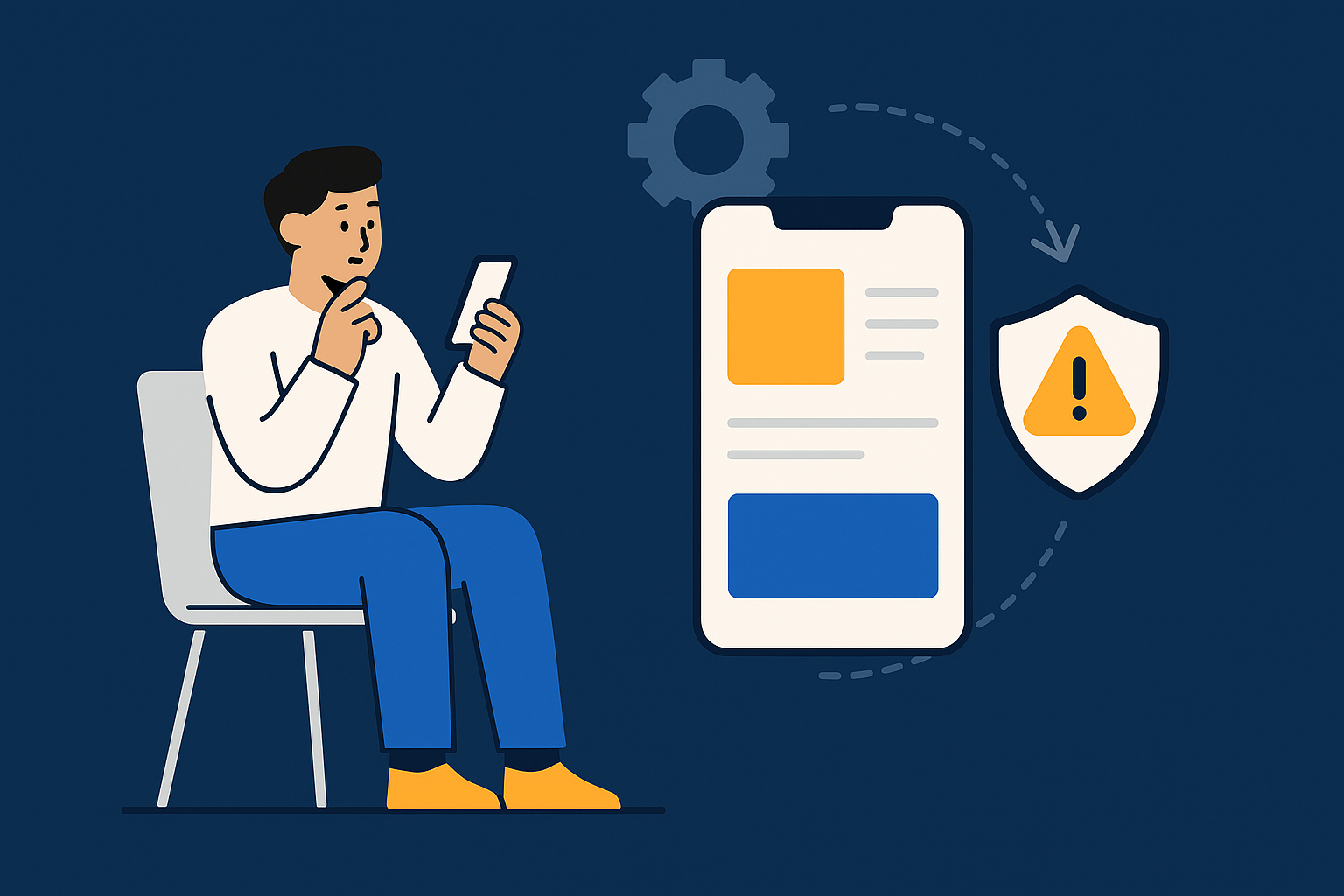Introduction
Mobile platforms move fast. OS releases shift permissions and background behaviors, SDKs deprecate, store policies tighten, and privacy rules keep evolving. For organizations whose revenue or operations rely on mobile, these shifts aren’t “nice to know”—they’re material risks to acquisition, activation, retention, and even compliance. The right consulting approach can turn that volatility into an advantage: anticipate change, ship safely, and keep product momentum without firefighting every quarter.

At CoreLine, we work with executives and product leaders who manage complex app portfolios—often tied to custom web apps, enterprise systems, and partner ecosystems. This article distills a proven playbook for mobile app consulting focused on platform risk. You’ll learn how to quantify exposure, align engineering and UX with business goals, and adopt release practices that protect both P&L and roadmap.

- This article is part of CoreLine’s Executive Playbook series on mobile and cross‑platform delivery.
- No live event is scheduled at the time of publication (October 28, 2025).
- If you’re planning an internal workshop on app risk and release governance, our team facilitates customized sessions for product, engineering, security, and marketing stakeholders.
Why You Shouldn’t Miss It
- Practical, board‑ready language for explaining mobile platform risk and mitigation.
- A compact risk model you can apply in one sprint across apps and SDKs.
- Architecture, UX, and release patterns that cut rollback risk and shorten time‑to‑mitigation.
- Clear KPIs that connect engineering work to revenue, CAC/LTV, and compliance outcomes.
- Templates you can adapt for procurement, budgeting, and vendor coordination.
What “Platform Risk” Means for Executives
Mobile platform risk is the probability that an external change—OS behavior, store policy, device capability, SDK update, or privacy rule—degrades your product outcomes or violates your obligations. It typically manifests as:
- Acquisition and attribution breaks that distort CAC and channel ROI.
- Permission prompts and copy that depress opt‑ins and feature adoption.
- Background execution changes affecting notifications, sync, and location‑based value.
- SDK end‑of‑life, security disclosures, or license changes that force emergency updates.
- App Store/Play policy shifts that delay releases or risk delisting.
- Accessibility and performance regressions that increase churn and support load.
A robust consulting engagement brings structure: measure exposure, design guardrails, plan mitigations, and institutionalize release practices that keep your app portfolio stable while you scale.
A Mobile Platform Risk Model You Can Use This Quarter
We recommend assessing each app (and major feature) across four dimensions. Score each 1–5, then multiply for a composite priority score.
- Lifecycle Volatility
- How frequently does the OS, store, or critical SDK introduce breaking changes to this feature?
- Dependency Criticality
- If this feature breaks, what’s the business impact—revenue at risk, SLAs, or brand trust?
- Exposure Level
- What percentage of your active users rely on it? Does it serve key customer journeys?
- Time‑to‑Mitigate
- How fast could you ship a fix given code modularity, test coverage, release tracks, and approvals?
A high composite score flags candidates for immediate action. This model also helps quantify the benefit of foundational improvements (e.g., modularization or release automation), not just feature work.
Consulting Engagement Outline: From Assessment to Runway
1) Discovery and Evidence (1–2 weeks)
- Portfolio inventory: apps, versions, SDK map, permission usage, and store policy posture.
- Telemetry snapshot: crash‑free sessions, ANR hotspots, cold start time, opt‑in funnels, review keywords.
- Draft Platform Risk Register: feature‑level entries with owners, score, and mitigation options.
- Executive brief: business impact summary and a 90‑day action plan.
2) Architecture Guardrails That Reduce Blast Radius
- Modularization and dependency isolation so a partner SDK update doesn’t stall your entire release.
- Remote configuration and kill switches to disable unstable features without a full rollout.
- Server‑driven UI for copy, prompts, and experiment variants—keep UX compliant without waiting for app review.
- Observability-by-default: structured logs, breadcrumbs, and alert thresholds that match SLOs.
3) UX/UI Patterns That Protect Conversion and Compliance
- Progressive disclosure for permissions: ask when value is clearest, not at first launch.
- Microcopy and visuals tuned for consent clarity and accessibility, reducing drop‑offs and risk.
- Empty‑state and degraded‑mode designs so features fail gracefully during OS or API changes.
- Inline education that explains “why this permission” in business terms users understand.
4) Release Engineering and Governance
- Staged rollouts with automated health gates (crash/ANR thresholds, vital KPIs) before 100% release.
- Beta tracks and internal distribution for fast validation across devices and locales.
- Rollback playbooks with decision owners and timers—treat them like incident runbooks.
- Cross‑functional release review: engineering + UX + legal/marketing sign‑off aligned to risk register.
5) Operating Rhythm
- Monthly risk review: update scores, close mitigations, and reprioritize with new OS betas/SDK notices.
- Quarterly runway planning: sequence hardening work alongside feature bets to maintain speed.
- Vendor alignment: ensure your custom web app development agency, analytics partner, and cloud ops share calendars and deprecation watchlists.
Patterns That Consistently Pay Off
- Consent as a flow, not a modal: teach value, demonstrate utility, then ask.
- Background task alternatives: design with constraints in mind; favor server notifications or user‑initiated sync where platform rules are strict.
- In‑app update nudges tied to benefits users feel, not generic “new version available” copy.
- Offline‑first essentials for business‑critical tasks: queue actions and reconcile on reconnect.
- Feature flags on all external dependencies: toggle risky surfaces independently of app binaries.
- Lean crash loops: cap retries, surface “safe mode,” and prompt users into a known good path.
Budgeting the Work: Connecting to CFO/COO Priorities
Executives don’t buy “technical elegance”; they fund predictable outcomes. Frame the plan around:
- Risk burn‑down: the percentage of high‑score items addressed per quarter.
- Time‑to‑mitigate: median days from issue detection to safe rollout.
- Release stability: crash‑free sessions and rollback frequency.
- Conversion resilience: permission opt‑in rates and core funnel drop‑offs across OS updates.
- Support cost: ticket volume tied to platform shifts.
Treat foundational improvements as risk‑retirement investments. For example, one sprint to isolate a payments SDK can eliminate multi‑week release freezes later. If you’re scoping a new initiative, specify where MVP development services include guardrails from day one—so you avoid rework when policies change post‑launch.
Signals You Need Mobile App Consulting Now
- Your last two releases required emergency hotfixes or rollbacks.
- Reviews mention crashes, permissions confusion, or feature inconsistency across devices.
- A critical SDK is nearing end‑of‑life or has a known vulnerability.
- Privacy prompts and consent rates are trending down, hurting analytics and personalization value.
- Teams debate policy interpretations late in the cycle, delaying releases.
- Release cadence is slow because one risky dependency blocks every cut.
Sample Deliverables You Can Put to Work
- Platform Risk Register (spreadsheet + owner map) with prioritized mitigations.
- Release Readiness Checklist aligned to App Store/Play review and internal SLOs.
- Architecture Hardening Plan: dependency isolation, flags, remote config, observability.
- UX Consent Playbook: permission timings, microcopy library, accessibility guideposts.
- Executive Brief: business case, KPIs, and a 90‑day roadmap with cost/benefit.
Mini Scenario: From Firefighting to Forecastable
A consumer services company ran a flagship app with heavy reliance on a third‑party SDK. OS changes and a policy update triggered crashes and opt‑in declines, causing paid acquisition to underperform. CoreLine led a two‑week assessment, isolated the SDK behind a feature flag, re‑sequenced permission prompts, and implemented staged rollouts with health gates. Within the next cycle, crash‑free sessions improved, opt‑ins recovered, and the team returned to a biweekly release cadence—without sacrificing new feature work.
How This Plays With Web and Enterprise Systems
Few mobile apps stand alone. If your platform also includes a web application or enterprise APIs, coordinate platform risk across the stack:
- Align release calendars across mobile and web teams to avoid breaking cross‑channel journeys.
- Version APIs explicitly with compatibility windows, so mobile clients can upgrade independently.
- Use the same observability vocabulary (events, IDs, error taxonomies) across channels for faster incident resolution.
- Ensure your custom web app development agency shares the same deprecation and policy watchlist—mobile and web teams should not be surprised by each other’s dependencies.
Practical Information
- Reading time: ~12 minutes
- Who should use this playbook: CEOs/COOs accountable for growth and risk, CTOs/VPs Engineering, Heads of Product, Design/Research Leads, and PMOs coordinating portfolio delivery.
- Getting started: commission a two‑week Platform Risk Assessment that inventories dependencies, scores exposure, and delivers a 90‑day plan.
- Engagement model: fixed‑scope discovery followed by outcome‑oriented sprints (risk burn‑down, time‑to‑mitigate, and release stability as core KPIs).
- Coordination: we work alongside internal teams and incumbent vendors to raise release quality without slowing delivery.
Conclusion
Mobile success isn’t just about shipping features—it’s about shipping them safely through continuously shifting platforms. With a clear risk model, the right architecture guardrails, consent‑savvy UX, and disciplined release engineering, you can protect revenue, reduce uncertainty, and keep your roadmap moving.
If you’re ready to make platform risk a competitive advantage, contact our team to plan your assessment.






